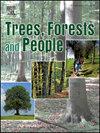考察埃塞俄比亚西部 Kellem Wollega 地区本土农林业实践中木本植物的多样性
IF 2.7
Q1 FORESTRY
引用次数: 0
摘要
在农田中种植木本植物不仅能促进生物多样性保护,还能通过提供必要的生态系统服务来支持当地社区的生计。本研究旨在评估埃塞俄比亚西部 Kellem Wollega 区本土农林业实践中的木本物种多样性。Kellem Wollega 有三个区:Dale Sadi、Gawo Qebe 和 Sadi Canqa。共调查了 135 块地,每个区 45 块,涉及不同的土地利用等级,记录了物种多样性、均匀度、丰富度、频率和重要价值指数。共统计了 29 个科的 56 个木本物种。经鉴定,最主要的是豆科,有 7 个物种(12.5%),其次是桑科和大戟科,各有 4 个物种(7.17%)。在已确定的物种中,约 71.43% 属于乔木,28.57% 属于灌木。这一结果证实,本土家庭菜园农林业的木本物种多样性最高,而林地的多样性最低。此外,研究结果表明,不同土地利用类别的物种多样性存在显著差异(p < 0.001)。这些结果凸显了本土农林业做法在提高生物多样性和支持生态系统中多种木本物种方面的贡献。本文章由计算机程序翻译,如有差异,请以英文原文为准。
Examining woody plant diversity across indigenous agroforestry practices in the Kellem Wollega zone, Western Ethiopia
Growing woody plants on farmland not only promotes biodiversity conservation but also supports the livelihood of local communities by offering essential ecosystem services. The present study aimed to assess the woody species diversity within indigenous agroforestry practices in Kellem Wollega Zone, western Ethiopia. From Kellem Wollega, three districts: Dale Sadi, Gawo Qebe,and Sadi Canqa were purposively selected. A total of 135 plots were surveyed, with 45 plots per district across various land use classes, documenting species diversity, evenness, richness, frequency, and important value index. Fifty six (56) woody species from 29 families were counted. Fabaceae family was identified as the most dominant, comprising 7 species (12.5 %), followed by Moraceae and Euphorbiaceae families, each with 4 species (7.17 %). About 71.43 % of species identified species were categorized as trees, while 28.57 % were classified as shrubs. This finding confirmed that the indigenous home garden agroforestry exhibited the greatest diversity of woody species, while woodlots exhibited the lowest diversity. Furthermore, the results indicate significant variations in species diversity across different land use categories (p < 0.001). These results underscore the contribution of indigenous agroforestry practices in enhancing biodiversity and supporting a number of woody species within their ecosystem.
求助全文
通过发布文献求助,成功后即可免费获取论文全文。
去求助
来源期刊

Trees, Forests and People
Economics, Econometrics and Finance-Economics, Econometrics and Finance (miscellaneous)
CiteScore
4.30
自引率
7.40%
发文量
172
审稿时长
56 days
 求助内容:
求助内容: 应助结果提醒方式:
应助结果提醒方式:


